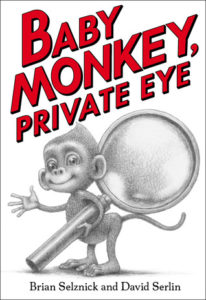 Story by Brian Selznick and David Serlin, Illustrated by Brian Selznick
Story by Brian Selznick and David Serlin, Illustrated by Brian Selznick
Who is Baby Monkey?
He is a baby.
He is a monkey.
He has a job.
He is Baby Monkey, Private Eye!
Lost jewels?
Missing pizza?
Stolen spaceship?
Baby Monkey can help…
if he can put on his pants!
I love Brian Selznick’s books and was excited for this one. A lot of the story is repetitive, making it great for emerging readers. It has almost 200 pages, but a lot of them are pictures. His illustrations are amazing and filled with details. You can spend a lot of time just looking at the pictures. It is a super simple story that will have the kids laughing, rspecially as the monkey tries to put on his pants.
Review by Vanessa Eyre, Robert Frost Elementary Media Center
Rating: ★★★★½ (4.5 stars)
Interest Level: Grades PreK-3
Baby Monkey, Private Eye
Story by Brian Selznick and David Serlin, Illustrated by Brian Selznick
Scholastic Press
191 pages
Release Date: Feburary 27, 2018
A review copy was provided by the publisher.





I love this book! I read on a Caldecott watch list that it is controversial — does anyone know why? Maybe I dreamed that up!
Dian,
I came across some conversations about this on Twitter a while ago, but I wasn’t able to find them today. Instead, the best source talking about this problem I’ve found so far is librarian blogger Edi Campbell. I’ll share some links to her writings below.
To try to sum it up from what I understand: because of the long but also recent history of racist cartoons and language equating Africans and African Americans with monkeys and apes, books with anthropomorphic monkey characters are just seen by many as inherently problematic, even if the author or illustrator had no consciously racist intentions in creating the books.
In her review of this book (https://campbele.wordpress.com/2018/10/02/review-baby-monkey-private-eye/), Campbell ultimately determines that the author and illustrator here had the best intentions in writing this book, but that’s not enough. A quote from one of her other posts on this subject sums up the issue pretty well:
“Monkeys and apes perpetuate white imperialism in children’s books. Sentiments combining their images with African Americans began in tandem with the notion of race and they continue to be used to perpetuate racist views. Sure. there’s not always intentional misrepresentation, but when you know the history, you know how the images can be interpreted. And, when you know better, you have to do better.” (https://campbele.wordpress.com/2018/04/26/on-negroes-monkeys-and-apes/)
She has another post which collects a series of other links on this subject: https://campbele.wordpress.com/2018/07/20/monkey-business/
Hope this is helpful. Looking at these posts certainly has been eye-opening for me. At times I’ve felt vaguely uneasy about these kinds of books but hadn’t been able to specifically identify or articulate the problems with them until now.